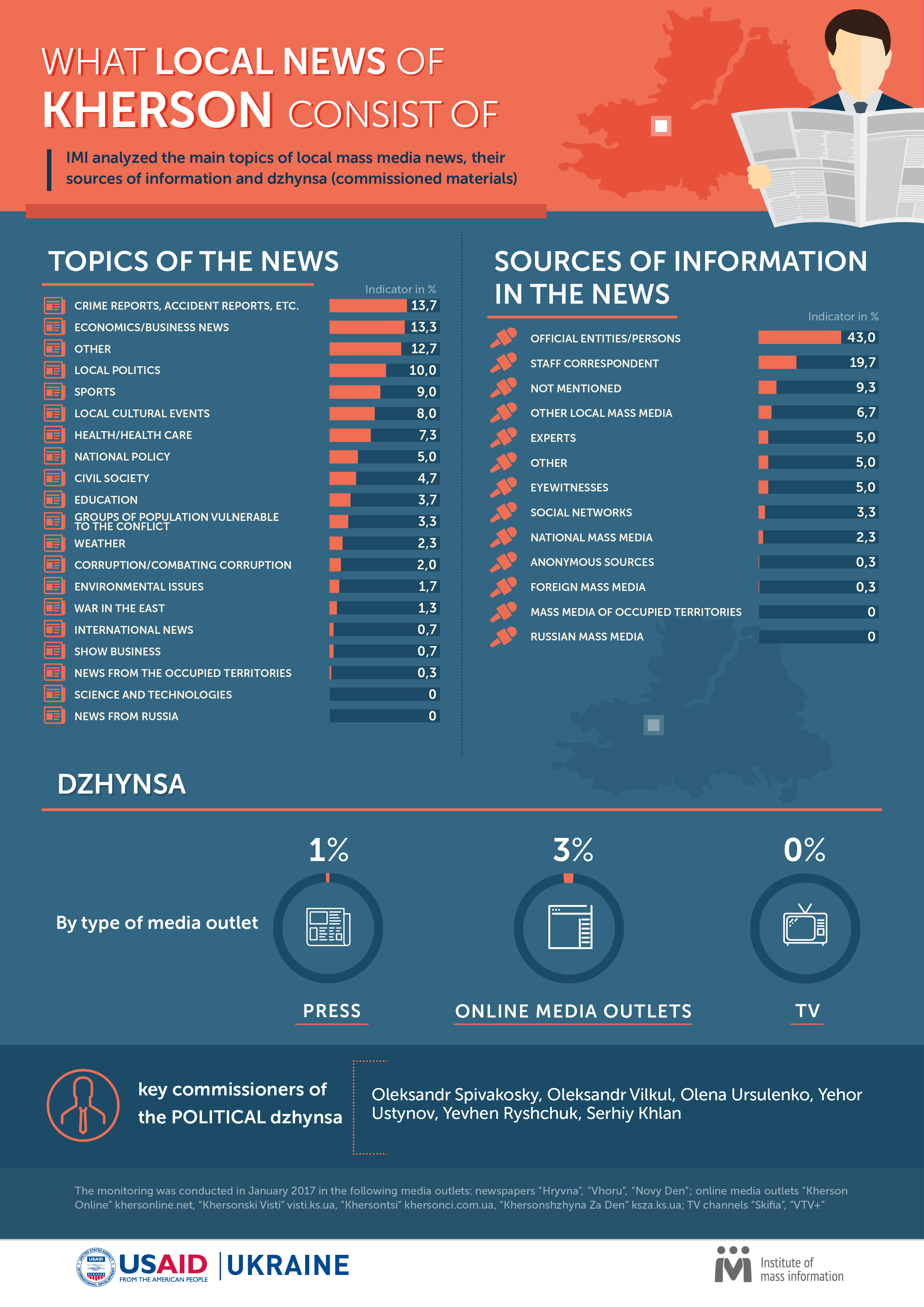The population of Khersonska oblast as of November 1, 2016, was 1,057,230 people, of them urban population — 61.2%, and rural population — 38.8%. According to the data of the local department of justice in Khersonska oblast, as of January 10, 2017, 288 printed media outlets were registered, and according to the data of the website of Khersonska Oblast State Administration — 12 TV and Radio Companies. The number of informational websites is presently over 40.
In the oblast center, six TV channels broadcast, three of them having a digital license. At that, about 20% of the residents of the oblast still do not receive the broadcasting signal of local media outlets, and in some places, do not even have access to national channels. In the rayons bordering the occupied Crimea, this problem is partly being solved by construction of the new TV tower, which is intended for broadcasting for the peninsula. Presently, local radio stations started their broadcasting through the Chonhar radio tower.
The language policy of the media in the region is far from being uniform. While TV channels broadcast almost entirely in Ukrainian, other types of mass media create content in two languages, or are using Russian only. Newspapers targeting the oblast center, «Hryvna» and «Vhoru,» are issued in Russian, while «Novyi Den'», which targets readers from the periphery, prefers Ukrainian.
Online media outlets are prevalently in Russian. The editors explain that this helps increase the number of visits and indexing of websites.
The market of printed media outlets and TV channels has stabilized. This is indicated by the fact that in the last two years, unlike in other oblasts, not a single TV channel or large newspaper closed down. Yet, new printed media outlets and TV channels did not emerge either; from this, we can conclude that the market is balanced (though the advertisement market is narrow). The same, however, cannot be said about online media outlets. Their number continues to grow, yet quality has decreases considerably. It is difficult to identify the number of such media outlets exactly, because a new website emerges almost every month.
Topics of news in local media
The most popular topic covered by printed media outlets in Kherson is crime. This topic features in 19% of news in local newspapers. The same share of news in the online media outlets of the region addresses economic and business news. As to the TV, the most popular news here is sports news — in the broadcasts of the summary news issues on TV channels «Skifiya» and «VTV+», they comprised 16%.
Interestingly, in the neighboring Mykolaiv, the most popular topic in the newspapers and on TV is local politics (17 and 19%, correspondingly), and in the online media — crime reports (31%). The situation is similar in Zaporizhzhia: newspapers and TV there pay more attention to the local politics, and the online media — to crime reports.
In Kherson news, local politics enjoys unusually low coverage. For example, in the printed press, only 8% of the materials are on this topic, on TV — 7%, and in online media outlets — 15%.
National politics is not very popular among the local journalists, either. In all three types of media outlets, it is covered in 5% of news.
Local cultural events are covered most often on TV (11% of news) and online (9%), while in newspapers, only 4% of materials cover them. The topic of show business is not covered at all on TV and online, while in newspapers, as a rule, materials on this topics are published near the TV guide and only take up about 2% of the reader's attention.
Traditionally, in winter the regional media cover health care problems for the local audience. The specificity of such materials is sometimes so intertwined with the local politics that it is difficult to identify the topic exactly. This pertains primarily to the issues of the medical reform. In the newspapers, the share of materials covering health care is 8%, on TV and in online media outlets — 7% in each category.
Local journalists show little interest in the issues of education, civil society, or the conflict-affected groups of population. In printed and online media, these topics are covered in 2-3% of all published news, on TV – from 5 to 9%.
Local authors pay almost no attention to the war in the East of Ukraine. We found 1% of news on this topic in newspapers and in online media outlets, and 2% — on the TV channels.
The only topic that the journalist of Kherson ignore completely is the news from the Russian Federation. We did not find any news on this topics.
Covert advertisement in local media
The frequency of commissioned materials in Kherson media is low, which can be explained by the relatively calm period in the political life of the region.
The leaders by the quantity of covert advertisement are, just as before, online media outlets, where the prices for publishing such materials are several times cheaper, than on TV, radio or newspapers.
For example, 3% of all materials in news of the monitored websites had markers of being covertly commissioned. At the same time, for the newspapers this indicator was on the level of 1%. In online media outlets, out of 3% of dzhynsa, 2% was political, and 1% – commercial; in the newspapers, this indicators was 1% and 0.3%, correspondingly.
By the number of materials that have markers of being covertly commissioned, the leader was the website «Khersontsi». An absolute leader by the number of commissioned materials is the MP from «Petro Poroshenko’s Bloc» Oleksander Spivakovskyi. Exactly a half of dzhynsa materials in local media are dedicated to the activities of this politician. At that, in the printed press, there are no commissioned materials about him or his activities. The second place here belongs to the MP from «Opposition Bloc», Oleksandr Vilkul. Materials about his activities and his political statements are published by both online media outlets and printed press. The newspaper «Novyi den'» publishes materials about this politician in each issue, even on the same place on the page.
Also, online media outlets publish some commissioned materials about the activities of the secretary of Kherson City Council Olena Ursulenko and councilmembers from «Opposition Bloc» and «Petro Poroshenko’s Bloc» in the city council.
There were also registered cases of published commissioned articles with elements a smear campaign, which is unusual for the period between the elections. For example, the newspaper «Novyi Den'» and the website «Kherson Online» published materials about MP Ivan Vinnyk (PPB) that displayed markers of being commissioned.
Covert commercial advertisement in all types of media outlets of Khersonska oblast can be traced in 1% of materials. In local media outlets of the region, they employ this method to advertise Privatbank, Smart Holding, and several car brands.
It should be mentioned that in 4 out of 9 of the surveyed media outlets, no covert advertisement was found in news. Of the printed media outlets, this is the independent newspaper «Vhoru», and of electronic media outlets, the website «Khersonski Visti».
We also have to note absence of covertly commissioned materials in the news issues of the monitored TV channels «Skifiya» and «VTV+».
If the share of covertly commissioned materials in Kherson media outlets were to be compared to that in media outlets in other regions, we can state that the situation in general is similar. For example, the level of published commissioned materials here is the same as in the media outlets of Odesa (2% commercial and 1% political dzhynsa), but lower than in the neighboring regions of Mykolaiv (1% and 6%/, correspondingly) and Zaporizhzhya (3% in each category).
Sources of information for local media
The main source of information for Kherson journalists is official structures or authorized officials of these structures. 43% of all news was created using official statements from the governmental agencies and other structures. On TV, such stories comprise 54% of all news. Sometimes, the channels show the stories prepared by the State Emergency Service of Ukraine, about traffic accidents or other accidents without the journalist's work at all, which constitutes a «no-legwork» material of a peculiar type, which was not typical for the local TV before.
In the local newspapers, the percentage of materials with references to statements from official structures or officials constitutes 34%. We did not separate these materials into «no-legwork» and materials written by journalists, yet the former have a considerably smaller share, especially if you compare it to the news in online media outlets, where the same indicator is as high as 41%.
On some websites, the materials of this nature comprised almost a half of all news. For example, on the website «Khersonski Visti», 47% of publications are news, whose source of information was official statements.
For other websites, the situation is similar. The majority of such statements and materials are produced by press services and the websites publish them without editing or commenting.
About 20% of news in the media outlets of Kherson is the result of work of the medias’ own correspondents. Newspapers have the highest indicator (31%) here, and online media outlets have the lowest (7%). On TV, 21% of news are the result of work of correspondents. As a rule, these are journalistic stories (in case of television and online media outlets) or columns (in case of newspapers).
The specific source of news that is mostly characteristic of online media outlets is other media outlets, 7% of their published news come from it. For instance, the popular website «Kherson Online» takes 8.6% of its news from other media outlets. At that, we were counting these news stories as referring to another media outlet only if there was a specific reference. In reality, to our opinion, this indicator is a bit higher due to not indicating the sources of information. Another two per cent of news are reprints from the national media. The leaders here are newspapers. The largest number of such materials was identified in the newspaper «Vhoru». Online media outlets also reprint the news pertaining to Kherson region from the national media outlets.
Local TV channels of Kherson region do not broadcast news of other media outlets.
In 5% of news, the sources of information are experts, and the same percentage of news have eyewitnesses as sources. In TV stories, experts are the sources of information in 11% cases, and eyewitnesses – in 7%. In newspapers and online media outlets, experts are in the focus in 2% of news, and eyewitnesses are the newsmakers in 5% of materials in newspapers and 3% of online materials.
Based on the used methodology, social networks constitute the source for 3% of news in the media of Kherson. Yet, this indicator is low because traditional TV news and materials in newspapers do not use social networks entries as sources. For instance, during the time of the monitoring, we registered only 3 news stories among the materials of printed press that were written based on a Facebook entry, and on TV we did not see any such cases. Instead, in the online media outlets, they traditionally prefer this source due to the ability to receive information quickly and its ease of use. In spite of such sources often lacking reliability, 10% of news on the studied websites was created based on entries in social networks. The highest indicator (15%) was registered on the website «Khersontsi». A particular feature here is that many commissioned materials on this websites are reprints of opinions of local politicians, often with minor edits.
This indicator in the online media outlets of Kherson is two times lower than the average in the country. For instance, Mykolayiv online media outlets create 13% of their news based on social network entries.
We should mention that in 9% of cases, we were unable to identify the source of information, and in 5% of cases, the materials had other sources that are difficult to categorize as one of the types established by the methodology. The average indicators for these categories in all studied regions were equal to 7 and 5%, correspondingly.
Twice we discovered quoting or reprinting of news from Russian media outlets, which in total comprises an insignificant percentage – some tenths of one percent. The situation with foreign media outlets is similar. As a rule, these are news about show business or reviews of new movies. In the period of the monitoring, such materials were reprinted by the newspaper «Vhoru» five times.
The number of news created based on the words of an anonymous source was also insignificant. With the average national indicator of 0.5%, in Kherson the same indicator was about 0.3%. This type of news was found only in the online media outlets.
In addition, we did not register any cases of using materials of the media outlets from the occupied territories as sources.
The monitoring was conducted in January 2017 in the following media outlets: the newspaper «Hryvna» (number of copies 41,600, weekly), «Vhoru» (number of copies 16,000, weekly), «Novyi Den'» (number of copies 22,700, weekly); the online media outlets Khersonline.net (approx. 4,050 unique visitors per day), Visti.ks.ua (approx. 1,104 unique visitors per day), Khersonci.com.ua (data from counters not available), Ksza.ks.ua (approx. 920 visitors per day); the TV channels «Skifiya», «VTV+».
The monitoring was conducted by the experts of the Institute of Mass Information with the support of the Ukraine Confidence Building Initiative (UCBI), funded by the United States Agency for International Development (USAID).
The methodology is explained in more detail on the IMI website.





